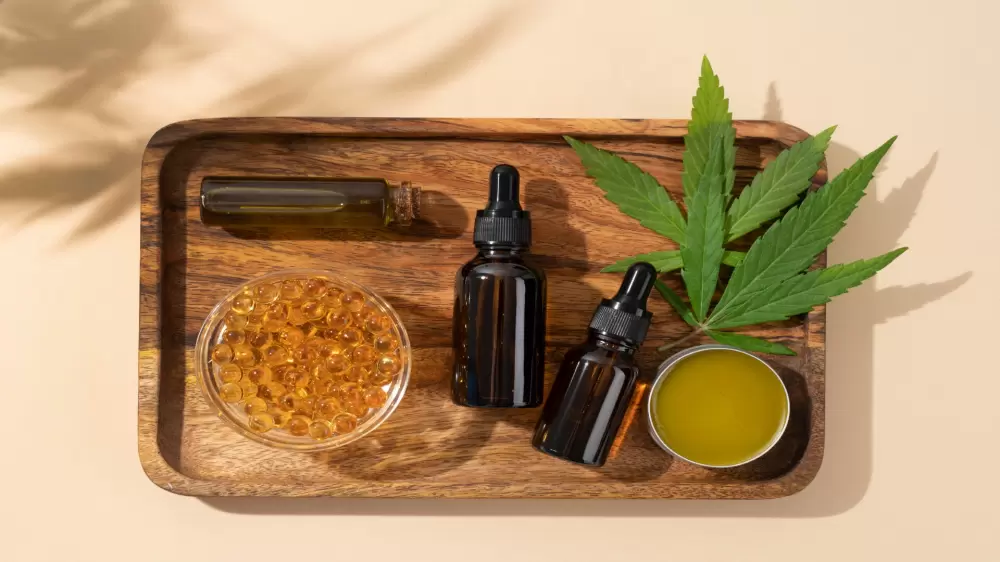OTHER ACTIVE INGREDIENTS IN CBD OIL: TERPENES

When you use a full spectrum CBD oil, it contains not only the well-known cannabinoid CBD, but also other substances. Think flavonoids, other cannabinoids and terpenes. Although this last group is not so well known, terpenes also have their own unique properties. If you want to know what terpenes in CBD Oil actually are and what they do, be sure to read on below.
Terpenes in CBD Oil
Anyone who uses CBD Oil has probably heard of CBD (cannabidiol) and perhaps some other cannabinoids, such as CBG. But while they have certainly earned their reputation, we should also pay some attention to terpenes. By now, some 140 different terpenes have already been discovered in cannabis. They are substances produced by trees, plants and even some animals, which are very important for survival. Terpenes play a role in defence. They cause the distinctive smells of trees and plants. Sometimes these are meant to repel insects, harmful bacteria, diseases and herbivores. But on the contrary, they can also attract beneficial insects. In addition, terpenes are important for the distribution of oxygen through the plant and are important for repairing damaged tissues.
The hemp plant has a distinctive smell that almost everyone recognises. This is therefore caused by terpenes. A full spectrum CBD Oil contains not only the cannabinoids from the hemp plant, but also the terpenes. Below, we list the best-known ones.
The 6 best-known terpenes
Caryophyllene
Caryophyllene causes a spicy and peppery smell. Apart from cannabis, oregano, black pepper and cinnamon also contain this terpene. It is possible that this terpene can have anti-anxiety effects. Studies with mice found that mice given caryophyllene showed less anxiety and compulsive behavior. In chronic pain, caryophyllene might also bring benefits. It could potentially have anti-inflammatory effects and therefore be used for neuropathic pain. This was shown by research on mice, in which both inflammation and pain decreased after administration of caryophyllene.
Limonene
Limonene causes the familiar smell of citrus fruit and pine trees. We usually find this smell pleasant. But apart from a nice smell, limonene can also have health benefits, both mental and physical. Limonene has been found to affect the production and availability of neurotranmitters, such as serotonin and adenosine. These affect mood. Due to these properties, scientists think limonene could potentially help with anxiety symptoms and depression.
Furthermore, limonene seems to have a positive effect on immunity. For example, it may promote the production of antibodies in the spleen. This terpene may also potentially help with chronic inflammation. Laboratory research suggests that limonene inhibits the production of nitrogen. Nitrogen plays a role in the development of inflammation.
Myrcene
Most people would describe the smell caused by myrcene as earthy and similar to cloves. Thyme, lemongrass, weed and hops contain myrcene. This terpene can have a calming effect. Many plants containing myrcene are therefore often used as sleep aids. It may also have anti-inflammatory and analgesic effects and could help prevent gastrointestinal ulcers.

Pineene
Do you love the smell of pine trees? It is caused by the terpene pineene. Rosemary, basil, mint and dill are also rich in pineene. A lot of research has been done on the effects of pineene. For instance, it appears to be able to have a positive effect on memory. In mice suffering from memory loss, administration of pineene showed a 72% improvement in memory.
In addition, pineene has antibacterial properties. Research showed that both alpha-pinene and beta-pinene, were very effective in fighting the bacteria that cause endocarditis. Possibly, pineene could be used more often in the fight against bacteria. Furthermore, this terpene could also inhibit inflammation and could, for example, be used as a remedy for inflammatory diseases such as osteoarthritis.
Humulene
The smell of humulene is woody and earthy. Herbs such as sage, cloves and hops contain humulene. Research has been done on the anti-inflammatory properties of humulene. It seems that this terpene is as effective in inhibiting inflammation as regular drugs, such as dexamethasone. In doing so, it also has analgesic effects.
Humulene, like pineene, further has antibacterial properties. Research was done with the oil of the balsam fir, and it was tested against several bacteria. One was Staphylococcus aureus, a bacterium that can cause serious infections of the lungs, bones or skin. All the active ingredients in the balsam fir oil (including humulene) were effective in fighting S. aureus.
Linalool
Linalool produces a nice, fresh floral scent similar to lavender. You can encounter it in basil, bay leaf and coriander. Research shows that linalool could have a calming effect on anxiety and stress, adding that the substance may also make the body itself less prone to stress. Stress can have a negative effect on your immunity. A change takes place in the distribution of white blood cells, so you have fewer lymphocytes and more neutrophils, for instance. Studies on rats show that this change does not occur after administration of linalool. So the substance could potentially help protect against the negative effects of stress, helping to maintain your resistance.

















